I grew up in a Hyundai. My family wasn’t particularly well-off, but I still remember the sheer joy and pride on my father’s face when he walked out of the showroom with the keys to a brand-new, off-peak Hyundai Getz more than 20 years ago. It was a big deal—our first family car.
That little Getz became a cornerstone of my childhood. It was there for countless school runs, weekend breakfast outings and family excursions. It bore witness to every sibling argument I had with my younger sister—probably wishing it could honk at me in reprimand for picking fights. So, you can say that Hyundai is a brand that I hold close to my heart.
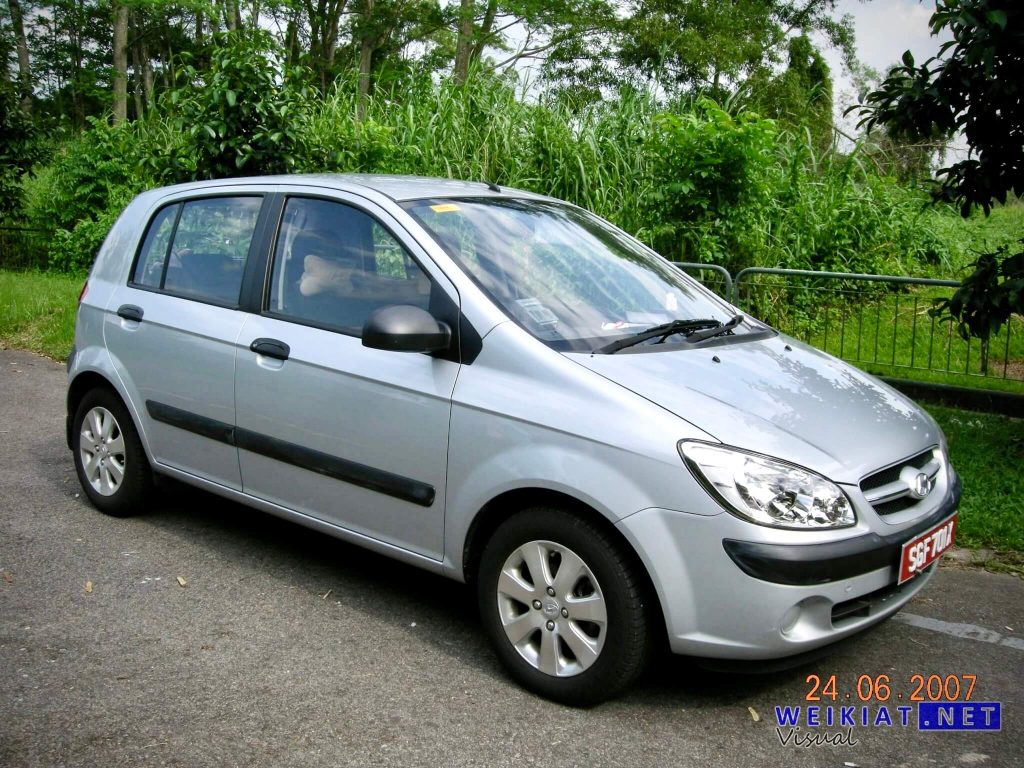
Our first family car. Photo © Calixto Tay
Ever had that warm sense of familiarity when you step into a car from one of the traditional automobile manufacturers? It’s a connection built on decades of history, craftsmanship, and memories. And, there’s something deeply comforting about seeing an electric vehicle (EV) from a traditional automobile manufacturer.
That’s an intrinsic value that the newer EV makers, no matter how advanced, simply can’t replicate.
I got that comforting sense of familiarity when I stepped onto the Hyundai premises in the far west of Singapore in Jurong.
Proudly Made In Jurong
Naturally, with such a nostalgic badge—and my test car sporting the same colour scheme as my father’s old Getz—I couldn’t resist bringing my father along for a ride to experience Hyundai’s latest offering.
When I told him this car was built right here in Singapore—specifically in Jurong, less than 5km from where his old kampong used to be—he was stunned. When I showed him photos of the factory floor at Hyundai Motor Group Innovation Centre Singapore (HMGICS), his jaws dropped further to the ground.
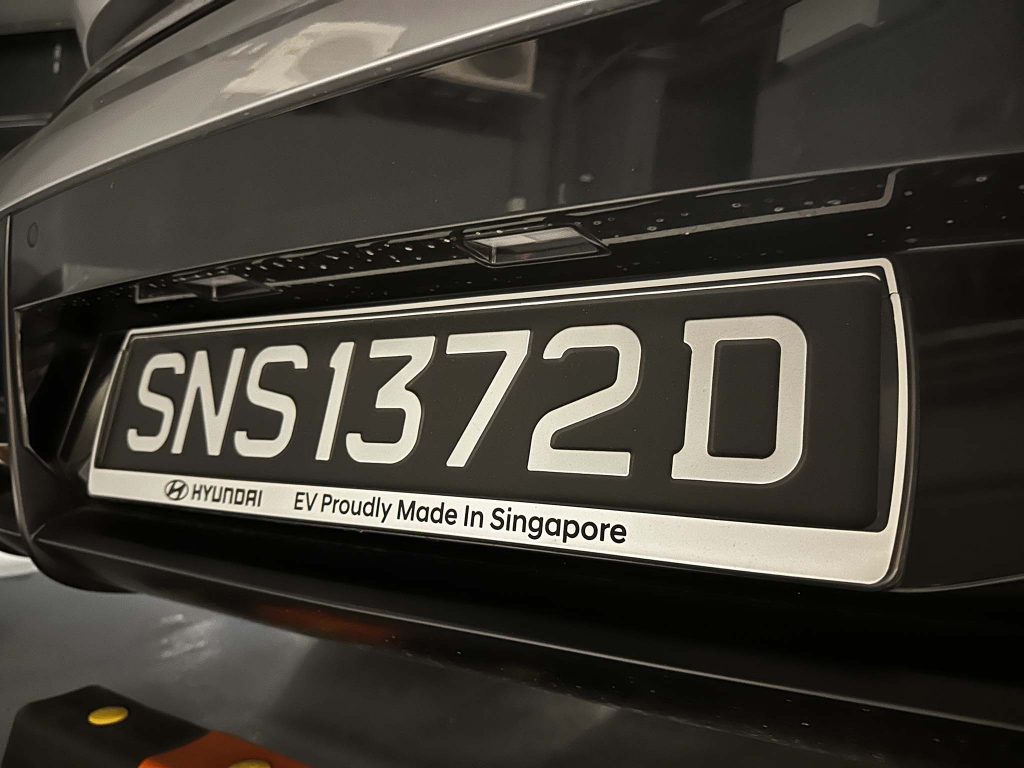
Proudly made In Jurong, actually. Photo © Calixto Tay
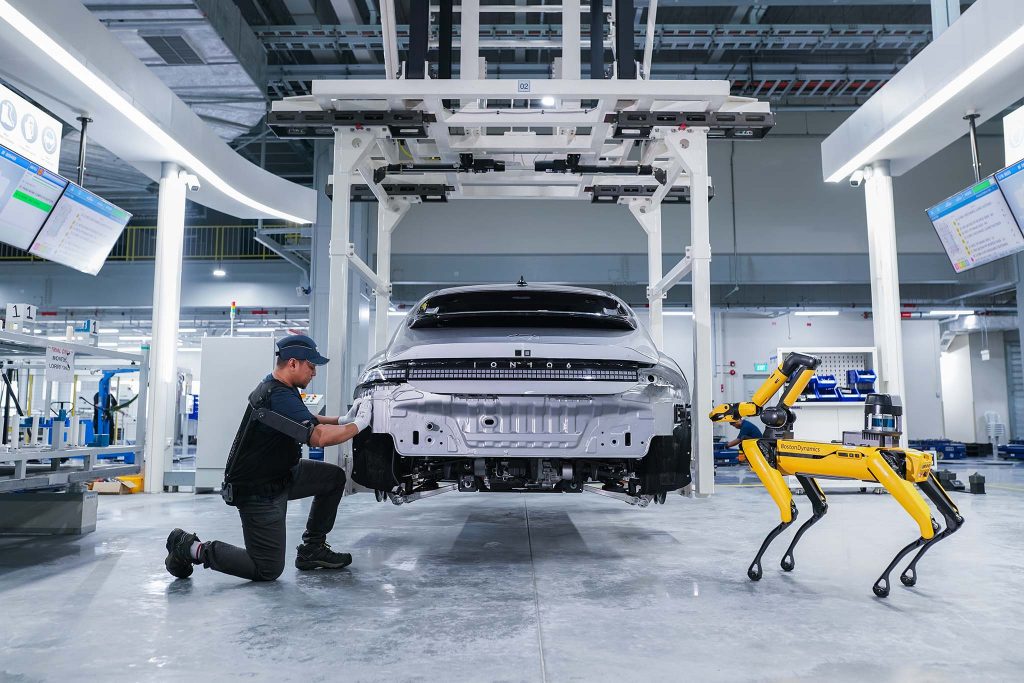
Photo © Hyundai Singapore

Photo © Hyundai Singapore
And when I showed him the test track on the roof of the sprawling HMGICS building? Let’s just say his reaction was nothing short of dramatic.
“This is in Singapore?” he exclaimed, wide-eyed, as if I had told him that scientists have found scientific proof that Merlion was a real animal once found in the swamps of Pulau Tekong.

Photo © Hyundai Singapore

Photo © Hyundai Singapore
Back to Business: The Review
Now, back to business. If you’re wondering why I’ve been rambling on without even talking about the Ioniq 6, here’s the reason: I think its design is extremely divisive–certainly not the old Hyundai design that I knew from my childhood days.
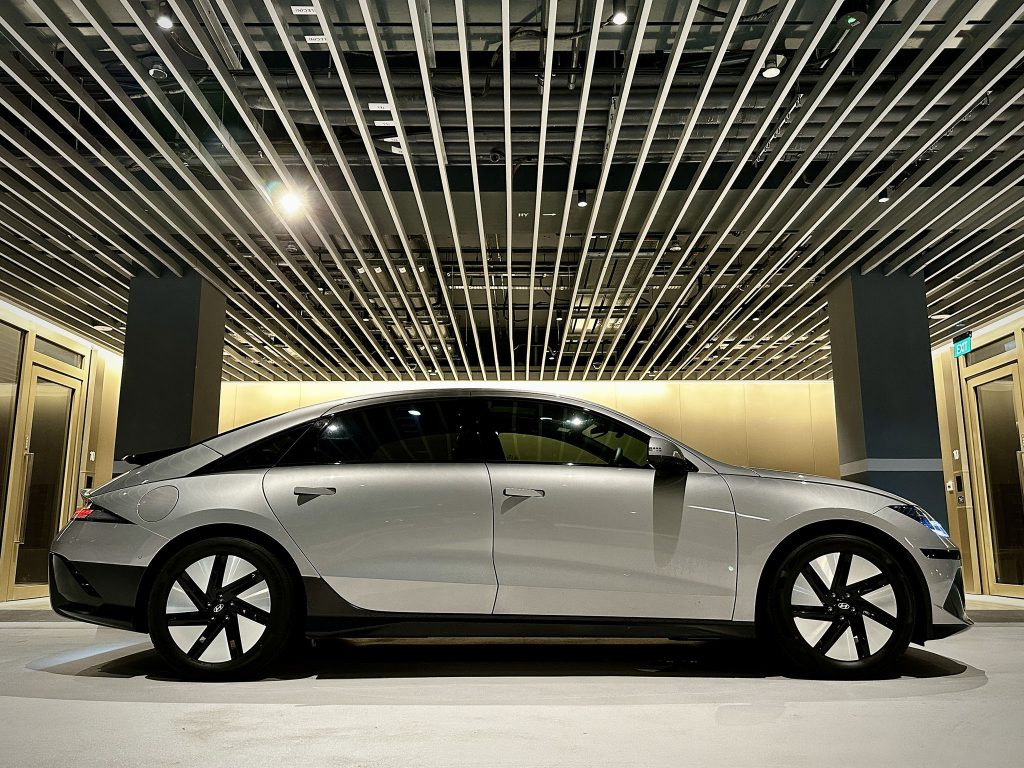
That divisive design. Photo © Calixto Tay
Those whom I’ve shown the car to are broadly divided into two camps: they either love it or hate it.
For those who love it, it’s cutting-edge, unique and futuristic, yet it manages to stay restrained, avoiding the “straight-out-of-a-sci-fi-movie” look. Plus, there’s a touch of retro-modern charm that adds a nice nostalgic twist. And they think that having a double spoiler at the rear is a better invention than Hainanese chicken rice.

Beautiful hindquarters. Photo © Calixto Tay
As for the haters, they think the front end looks odd, the double spoiler feels unnecessary, and the overall aesthetic seems like Hyundai borrowed too much from both vintage and modern Porsches.
Add in the pixel motifs from the Ioniq 5, and what you get is a rojak of design elements—one that somehow teeters between being a design marvel and not quite hitting the mark simultaneously.

Ribbit, ribbit, is this a frog? Photo © Calixto Tay
As for me, the front end didn’t quite do it for me. But, the rear? I absolutely love it. The double spoiler is a standout feature, and it’s easily my favourite part of the car.
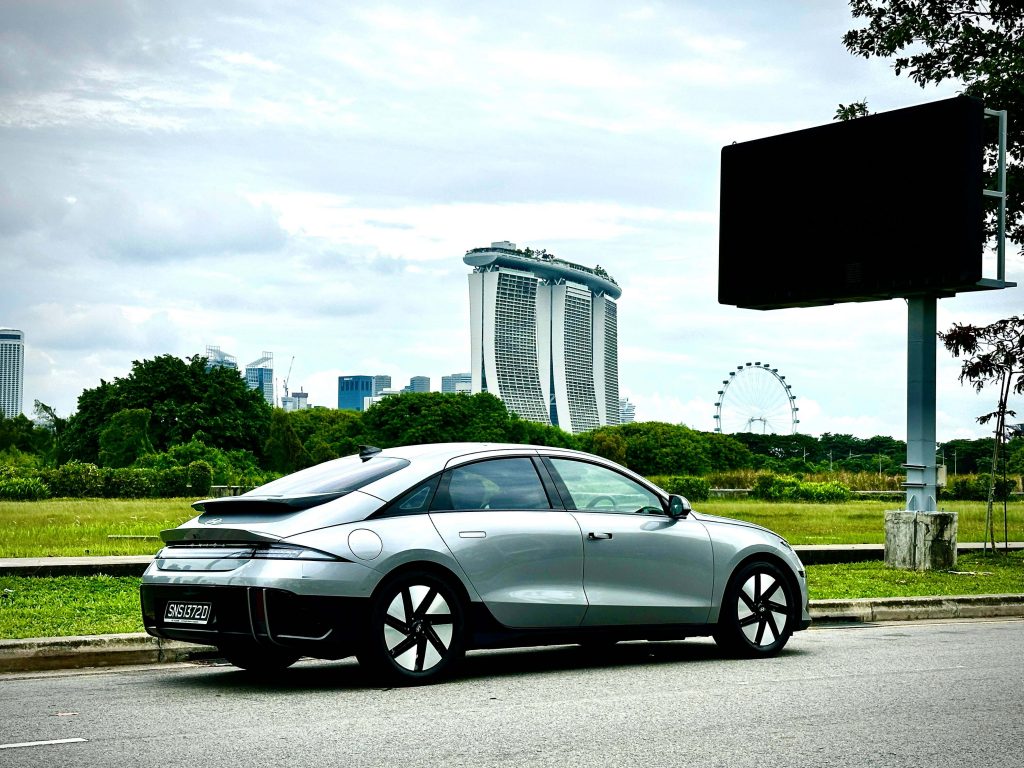
I love that backside. Photo © Calixto Tay
That rear spoiler with its integrated LED brake lights—it’s the kind of design that really speaks to the techno geek in me.

Beautiful spoiler with integrated LED brake lights. Photo © Calixto Tay
In the few days that I had with the Ioniq 6, I think more people loved the design than hated it. I’ve had more “cool ride, bruh” comments from random strangers at the carpark while driving the Ioniq 6 than I ever got with my personal luxury car—despite my own car costing over 1.5 times more than the the Ioniq 6.
Over my five-day test drive, I’ve grown to truly love and appreciate the refreshing design of this car.
A Car That Is Refreshingly Refreshing
You’d be forgiven for thinking that an EV from a traditional automobile manufacturer might be boring or uninspiring. After all, many EVs from established brands are essentially electrified versions of their fuel-guzzling counterparts.
The Ioniq 6 stands apart as a car designed as an EV from the ground up, featuring an atas (colloquial term for ‘premium’) interior that rivals those of luxurious German brands.
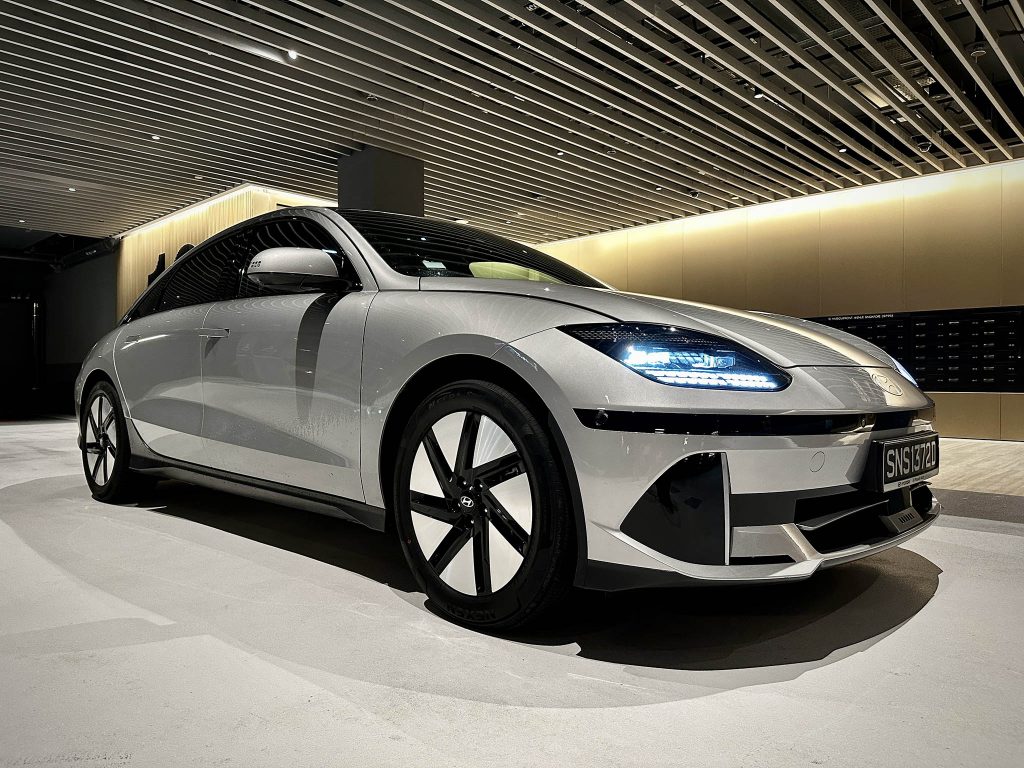
An atas Ioniq 6 in an atas condominium (The Reef at King’s Dock). Photo © Calixto Tay
A truly well-crafted vehicle isn’t just about looking good (especially when looking good has become standard for many made-in-China EVs). It’s about quality in every detail—from the materials you touch to the solid, refined sound of a closing door.
The Ioniq 6 boasts a satisfying, deep door-close thump, a well-executed interior with quality, posh materials and clean, refined design. “Cheap” plastics only make a rare appearance far down the console and door panels—putting it in contention with BMW or Mercedes-Benz.
While it’s best to experience the interior with all five senses, here’s the next best thing: a digital walkthrough. Feel free to pinch, pan, and zoom to explore every detail.
Interior in the day
Interior at night
It’s the little things that matter
The Ioniq 6 is packed with thoughtful, creative touches without resorting to unnecessary gimmicks. Here are some of my favourites (it’s quite a list):
Magical Glove Box Drawer
Ever opened your glove box, only for its contents to spill out in a chaotic avalanche? Or struggled with the frustration of digging through its cramped, unorganised space? Hyundai’s engineers reimagined the glove box as a drawer, making it easier to organise and access without the risk of disaster every time you open it.

That magical glove drawer. © Calixto Tay
And hey! The glove drawer even magically upgraded a Labubu into a Crybaby! Your mileage may vary.
The length of it all
When I first saw press photos of the Ioniq 6, I didn’t realise just how lengthy the Ioniq 6 actually is. It wasn’t until I parked it in a multi-storey carpark that I noticed the car filled up the entire parking lot—just with its wheelbase.
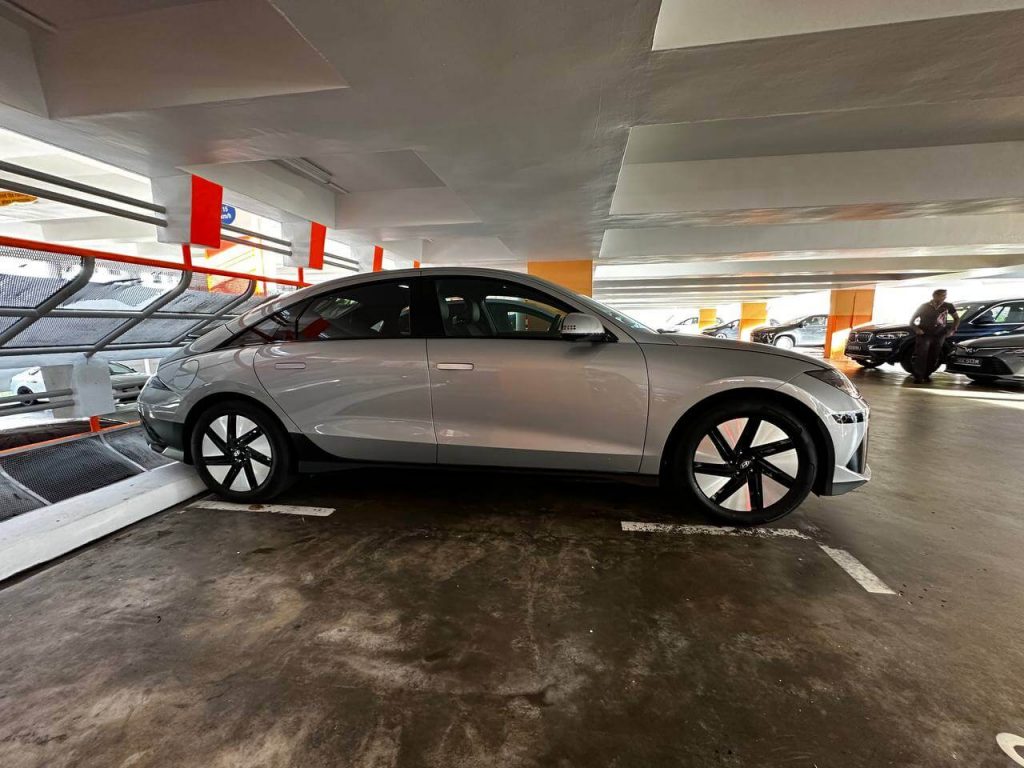
It’s unbelievably long (That’s what she said). Photo © Calixto Tay
At 2950mm, the Ioniq 6’s wheelbase is even longer than the 2022 Mercedes E-Class, which measures 2939mm. This translates to an incredibly spacious cabin, with ample legroom for both front and rear passengers. If you love a car that lets you stretch out in comfort, the Ioniq 6 is the one for you.
The glass roof
Recent EVs often come with stunning glass roofs that are, unfortunately, fixed in place. Not the Ioniq 6 – its glass roof opens, and our resident “Car Bear” is here gleefully waving at you through the roof.

Hello, Car Bear! © Calixto Tay
Head’s Up
The heads-up display (HUD) is sleek and highly functional, working in conjunction with the built-in navigation on the infotainment screen. ‘Nuff said.

Yeah crap, I’m two lanes away from the right one. Photo © Calixto Tay
That Door Bin
Door bins often become black holes for random items, only rediscovered a decade later when scrapping the car. The Ioniq 6 solves this with a translucent, glow-lit door bin. You can easily see what’s inside. It’s so elegant it could double as a Labubu display case. No more excuses for forgotten rubbish!

A “Door Bin”. Generated with the wonders of OpenAI.

A Labubu Display Cabinet. Er, I mean, a door bin. Photo © Calixto Tay
Power To The People
There’s a three-pin plug under the rear passenger seat. If your wife is still on the fence about this purchase, just remind her she can now blow-dry her hair with her Dyson Airwrap along the way as you chauffeur her to work.

This opens up endless possibilities of what you can use in your car. Photo © Calixto Tay
“Opening Up” Only When Necessary
Borrowing a trick from top performance cars like BMW, the Ioniq 6 comes standard with active air flaps. These clever flaps “open up” only when needed, letting in extra air for cooling.

Air flaps opened! Photo © Calixto Tay
Otherwise, they stay shut, helping the Ioniq 6 achieve an impressive 0.21 drag coefficient—because even your car knows when to keep things streamlined.

Air flaps closed! Photo © Calixto Tay
But, there’s one peculiar thing
As much as I love the Ioniq 6, there’s one peculiar feature I can’t quite figure out: Why is the seat adjustment control for the front passenger located at the side of the seat?
It’s almost as if Hyundai wanted to give rear passengers (your kids) the opportunity to mess with the front passenger (probably your wife) —because nothing says fun like a surprise mid-ride seat adjustment!

No Car Bear was harmed in the making of this video. © Calixto Tay
In all seriousness, those adjustment buttons are likely there for the driver to chivalrously assist in adjusting the seats for Passenger Princesses—think K-Drama.
And There’s That Trust Issue
Most modern EVs are packed with safety features, making it nearly impossible to turn them into bumper cars. But in the Ioniq 6, I felt the systems trusted me a little too little as a driver.
Swerve slightly off-centre in a corner? The steering assist takes over immediately to keep me perfectly in line. A car aggressively cuts into my lane behind me? Beeps and boops warn of a “collision” even if it’s half a car length away. Signal to change lanes with someone in my blind spot? The alarms go off like I’m about to start World War III.
I get that this is a made-in-Singapore car, and we do live in a so-called nanny state. But after over a decade of clean driving, I couldn’t help but feel a bit belittled—like my car didn’t trust me to know what I’m doing.
An Ioniq 6 for every budget and taste

Ioniq 6 comes in four variants.
I love that the Ioniq 6 comes in four variants, offering something for everyone. After putting both the Cat A Prestige 2WD and Cat B Prestige 2WD variants through their paces on the secret Calixto’s hill climb test track, I’ve crafted a simple decision guide to help you choose the one that’s perfect for you:
Driving Style
If you are in for nice bit of spirited driving, the Cat B Prestige 2WD would give you the closest feel to a respectable sports sedan in terms of handling and drive feel.
If you just view a car as something that brings you from point A to B, get either one of the Cat A variants.
If you are feeling competitive, and want to be the absolute fastest off the red lights, get the Cat B Inspiration 4WD.
Budget
If your wife doesn’t know how much you’re spending on the car, go for the Cat B Inspiration 4WD—it’s the top-tier choice.
But if she’s watching the budget like a hawk, do everything you can to negotiate for the Prestige 2WD. Trust me, the upgrade in trim is worth it. Even if it means 10 nights in the living room, it’s a small price to pay for 10 years of sheer bliss with the Prestige trim.
Access to Chargers
If you have nightly access to a charger, the ~300km range (53 kWh) variants are plenty. If not, go for the 77 kWh versions for extra range.
The Final Takeaway
I promised my editor I’d work on shortening my reviews, but here we are at nearly 2,000 words at the risk of incurring my editor’s wrath.
I’d quickly conclude with one final sentence: The Ioniq 6 is a solid family sedan, with German-like refinement, thoughtful quality-of-life features, versatile variants for every budget, and proudly made in Jurong.




